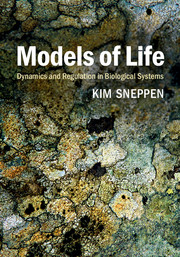Book contents
- Frontmatter
- Contents
- Preface
- 1 Life from a physics perspective
- 2 E. coli as a model system
- 3 Dynamics of regulatory links
- 4 Statistical mechanics of phage λ
- 5 Diffusion and randomness in transcription
- 6 Stochastic genes and persistent decisions
- 7 cis-Acting gene regulation and epigenetics
- 8 Feedback circuits
- 9 Networks
- 10 Signaling and metabolic networks
- 11 Agent-based models of signaling and selection
- 12 Competition and diversity
- 13 Evolution and extinction
- Appendix
- References
- Index
8 - Feedback circuits
Published online by Cambridge University Press: 05 October 2014
- Frontmatter
- Contents
- Preface
- 1 Life from a physics perspective
- 2 E. coli as a model system
- 3 Dynamics of regulatory links
- 4 Statistical mechanics of phage λ
- 5 Diffusion and randomness in transcription
- 6 Stochastic genes and persistent decisions
- 7 cis-Acting gene regulation and epigenetics
- 8 Feedback circuits
- 9 Networks
- 10 Signaling and metabolic networks
- 11 Agent-based models of signaling and selection
- 12 Competition and diversity
- 13 Evolution and extinction
- Appendix
- References
- Index
Summary
Small regulatory subnetworks
The interior of the cell is crowded with proteins, nucleic acids and metabolites; molecules with widely different properties and which each interact specifically with a few of the other ones. These interactions define a network of molecular species connected by links that represent interactions and flow of information. The links are often directed, and may differ widely in the time they need to transmit a “message.” For example, enzymatic conversion of small metabolites is usually fast, while synthesis of biopolymers is a much slower process. Importantly, most biological processes are regulated through feedback circuits, which involves both activating and inhibiting links.
Feedback loops (FLs) are formed when regulatory links are combined into a closed cyclic chain. Thus, the influence of each regulator in this cycle eventually loops back onto itself. Depending on the types of links in the cycle, this effective self-interaction can be positive or negative, and this strongly determines the behavior of the FL.
Feedback circuits and small regulatory networks (RNs) have been extensively studied, both experimentally and theoretically [25, 116, 142, 175, 238, 360, 361, 362, 363, 364, 365, 366, 367, 368, 369, 370, 371, 372, 373, 374, 375, 376, 377, 378]. Figure 8.1 shows RNs with various combinations of FLs. Panels A and B show case studies where a small molecule is “harvested” from the exterior of the E. coli cell, and then subsequently utilized within the cell.
Information
- Type
- Chapter
- Information
- Models of LifeDynamics and Regulation in Biological Systems, pp. 150 - 176Publisher: Cambridge University PressPrint publication year: 2014
